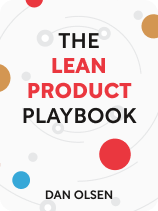

This article is an excerpt from the Shortform book guide to "The Lean Product Playbook" by Dan Olsen. Shortform has the world's best summaries and analyses of books you should be reading.
Like this article? Sign up for a free trial here.
Is there a systematic approach to creating successful products? How can you increase your chances of developing a product that customers actually want?
The Lean Product Playbook by Dan Olsen offers a practical guide to achieving product-market fit. It outlines a step-by-step process for finding target customers, assessing their needs, and crafting an effective product strategy.
Continue reading for an overview of this book.
Overview of The Lean Product Playbook by Dan Olsen
Does creating a successful product feel like a risky gamble? The Lean Product Playbook by Dan Olsen argues that product success doesn’t have to be left to luck: By making sure your product has product-market fit—that it satisfies customer needs better than other available options—you can be confident in its success. The book, published in 2015, provides a practical guide to finding product-market fit using the lean startup approach, presenting repeatable and systematic steps for identifying target customers, understanding their needs, and creating a winning product strategy. By following Olsen’s Lean Product Process, you can craft winning products with minimum time, effort, and costs.
While Olsen’s framework is designed for software products, many of his strategies can also be applied to physical and other types of products.
Olsen is an entrepreneur and product management expert. He founded Olsen Solutions to provide training and consulting, and the Lean Product Meetup to serve as a community for people interested in product development to share ideas and learn from one another. Olsen has worked with numerous high-profile companies and startups, such as Facebook and Microsoft, helping them build successful products and develop effective product management strategies.
In this overview, we’ll explore Olsen’s product development process in three stages. In Stage 1, we’ll discuss how to create a product idea that has product-market fit. In Stage 2, we’ll look at how to validate your product idea by creating and testing a minimum viable product. Lastly, in Stage 3, we’ll explore how to build your complete product and optimize it using key metrics.
Stage 1: Design a Product With Product-Market Fit
According to Olsen, product-market fit determines whether a product succeeds or fails. When you have a product-market fit, your product satisfies customer needs better than existing products on the market.
We’ll discuss Olsen’s steps for designing a product with product-market fit by gaining a broad understanding of your target market’s needs and planning a product that can meet those needs.
Understand Your Target Market
The first step to creating a winning product is building a strong understanding of your target market and their needs. Olsen advises that you thoroughly understand your target customer—get a clear idea of who they are, what problems they experience, and their wants and desires. When you understand all dimensions of your target customer’s lifestyle and needs, you’ll be better able to create a product you know they’ll want to buy.
Olsen suggests you do two things to gather, organize, and make sense of information about your market: Identify your target customer, and focus on problems, not solutions.
Identify Your Target Customer
First, Olsen suggests you create hypotheses about who your target customer is by identifying all relevant characteristics that people in your target market share. Consider four characteristics:
- Demographics—like age and gender.
- Psychographics—like values, attitudes, and interests.
- Needs—for example, the need for fast and efficient meal preparation.
- Behaviors—for example, people who regularly purchase prepared or easy-to-cook food items.
Once you’ve identified your target customer’s attributes, create customer personas that represent your target customer. Personas are detailed, fictional representations of your target customer—including names, representative photographs, relevant quotes, job titles, and so on. They give everyone on your product development team the same understanding of who the customer is. Personas can also help you decide what features to include when designing your product.
Olsen points out that your customer personas are only hypotheses because you can’t predict with complete certainty who will be attracted to your product until it’s actually on the market, so the process of defining your target customer should be continuous and repetitive. As you interact with more potential customers, revise and refine your hypotheses and personas.
Focus on Problems, Not Solutions
Once you have a clear representation of who your target customer is, explore their problems—but Olsen advises that you don’t yet brainstorm solutions. He argues that, when you start thinking about the possible products, features, or services that can solve your customer’s needs, you narrow your vision and block yourself from generating more creative, less obvious solutions. You may also end up coming up with solutions that don’t resolve the true problems your customers have.
For example, if your target customers are young adults looking to eat healthier, don’t immediately fixate on creating healthy meal plans that are easier to follow. Instead, dig deeper into the complexities of why most young adults tend not to eat healthier. You might realize that a lack of fresh produce is an issue, which can give you an idea for a feature that directly connects local farmers with consumers.
Conduct Discovery Interviews
Olsen recommends conducting customer discovery interviews when exploring customer needs: Hold one-on-one interviews with prospective customers and ask about various topics such as their interests, goals, and opinions about existing products in the market. You can also ask how valuable the benefits your product could offer would be to customers.
Identify High-Value Customer Needs
Olsen writes that, after you’ve thoroughly researched your target market’s needs, you should decide which needs you want your product to address. We’ll discuss how to calculate the value of each customer need and create your value proposition—a description of the unique benefits your product will provide for customers.
Calculate the Value of Each Customer Need
Olsen recommends you calculate the value of each customer need by assessing two factors:
Factor 1: How important the need is to your target customer. Your product becomes more valuable when it solves a problem your customers care deeply about. The key is to cater to their major issues or concerns so your product isn’t just useful, but essential.
Factor 2: How well existing products on the market meet each need. You want your product to satisfy customers more than other products on the market, so focus on customer needs that are not already met by existing products. This way you won’t have to contend with heavy competition.
Olsen suggests you measure these two factors by finding and surveying your prospective customers. Gather grades or scores for each factor—for instance, have customers rank the importance of each need on a scale of one to five and satisfaction on a scale ranging from completely dissatisfied to completely satisfied. Then, plot the scores on a chart or graph and see which needs are most valuable to pursue. Olsen writes that the best opportunities are needs that users consider most important but are least satisfied by existing products on the market.
Create a Value Proposition Table
Once you’ve calculated the value of each customer need, Olsen advises you to create a table that will help you examine which needs your product will address and how you’ll address them better than your competitors. He calls this a value proposition table.
In the first column of your value proposition table, list the needs your product will address. He recommends that you focus on a limited range of needs: Choose your customers’ most important needs, and choose needs that complement each other. For example, if you’re designing a fitness tracker, add features that directly support health monitoring (like calorie counting and sleep tracking) instead of something like weather updates that are only tangentially related. Being selective about what needs your product addresses allows you to use your resources more efficiently, avoid distractions, and deliver the most value with the least amount of waste.
Olsen recommends grouping these needs into three categories:
- Essential needs—basic needs or requirements your product must satisfy to be acceptable. For example, a video editing software must be able to cut, splice, and rearrange footage or it would be useless to prospective users.
- Performance needs—expectations that increase customer satisfaction when better fulfilled and decrease satisfaction if not adequately fulfilled. For example, users would be more satisfied by high rendering speed and the ability to handle high-resolution footage.
- Bonus needs—extra features that customers don’t necessarily expect but would be excited about if you provide them. For example, a video editing software might provide a built-in library of royalty-free music.
Next, create three more columns—one for your product and two for competing products. Score how well the two competing products currently satisfy each need and how well you plan to meet each need. Fill out the rows for essential needs and bonus needs with either a “yes” or “no,” and rate each performance feature as low, medium, or high in terms of satisfaction. For example, you might rate the rendering speed as low for Competitor A, medium for Competitor B, and high for your product if you intend to deliver this benefit well.
Stage 2: Validate Your Product Idea With a Minimum Viable Product (MVP)
At this point, you’ve created your product’s value proposition and have a clear idea of the needs you want your product to address. Now, it’s time to determine how your product will address those needs and then verify whether your product design actually resonates with your target market. You can do this by building and testing a minimum viable product (MVP).
Creating a fully functional product is time-consuming and risky since you haven’t yet validated whether customers would want to buy it. An MVP is a simplified, bare-bones version of your product. It consists of only the most critical features and functions needed to validate assumptions about your product. Olsen argues that building an MVP is the fastest and cheapest way to test your hypotheses and gather feedback on your product design. We’ll go through the steps to do so.
Choose Features for Your MVP
The first step in creating an MVP is to choose which features to include.
First, brainstorm all possible features that could satisfy each need your product will address. Then, select three to five of the best features and write user stories for them. A user story is a brief explanation of a feature from the user’s perspective. They typically follow this format: “As a [type of user], I want to [perform this action] so that I can [desired result].”
For example, “As a music enthusiast, I want to create and share playlists on a music streaming device so that I can share and discover new music with my friends.”
Once you’ve written user stories for your top feature ideas, calculate the ROI (return on investment) for each feature to determine which are worth pursuing. To do so, subtract the cost of building the feature from the revenue you’d expect to earn by including it, and then divide by the cost to get a percentage.
Olsen writes that you should greenlight features with high ROI for your MVP: ones that satisfy all essential needs, the top performance need, and the top bonus need from your value proposition. Including a bonus feature helps your product stand out from competitors.
Validate Your Product Idea
Once you’ve identified the features for your MVP, validate your product idea either by directly interacting with customers or by conducting tests. Olsen suggests you validate three things: the value of your product itself, your user experience (UX) design, and your product marketing.
Method 1: Conduct Customer Interviews
Olsen writes that conducting in-person interviews with target customers is one of the most effective ways to validate your product idea and UX design. Getting feedback from real prospective customers allows you to understand whether customers find your product valuable and why.
To validate your product idea, you’ll need to show customers some version of your product. Olsen recommends that you present a range of product design prototypes that allow you to test your hypotheses without having a completed product. The closer the prototype behaves and appears to the final product, the better and more accurate feedback you’ll get.
Olsen describes several design prototypes you can consider:
- Wireframes: A simple, sketch-like diagram showing the basic layout and functionality of your product.
- Mockups: A more detailed visual representation of what your final product will look like, including color, font, and images.
- Manual MVPs: Interactive versions of your product that require human involvement to simulate the experience of using the final product. One example is what’s known as a Wizard of Oz MVP, which has a human operator perform the tasks that would typically be automated in the final product, giving the illusion of a functioning system. This allows you to gather valuable insights before investing in further development.
Olsen suggests you also get feedback on your product’s user experience (UX) design. UX is how a user interacts with your product or service and makes use of its features. Olsen writes that a product with good UX is both intuitive and enjoyable to use. When you interview customers, get feedback on UX design by evaluating how easy it is for customers to complete certain tasks. The more effort required, the more difficult your product is to use and the less valuable it becomes to users.
Now that you know what elements of your product to test, how do you get quality feedback from customers? To conduct effective interviews, Olsen suggests you:
1. Recruit target customers. Advertise on odd job platforms like TaskRabbit, approach people in-person, or work with customer research companies. Aim to get five to eight customers per round of testing. To ensure you get customers in your target market, use screening questions that qualify or disqualify respondents. For example, if your product is for athletes, you might ask survey participants about their weekly exercise hours and exclude those who exercise less than 10 hours a week.
2. Conduct in-person interviews with one participant at a time. In-person interviews help you develop rapport with the participant and pick up on nonverbal cues. Additionally, people express themselves more truthfully when you interview them alone, leading to more accurate results. Olsen explains that people often hesitate to openly share their thoughts in front of others, and they may also change their beliefs after hearing other people’s opinions.
3. Ask open-ended questions. Some participants may be less expressive than others. As participants interact with your product prototype, encourage them to share their thoughts by asking open-ended questions—those that start with “why,” “what,” or how.”
4. Avoid intervening. Olsen suggests you avoid the temptation to step in when the participant has difficulty using your product. If customers ask for your input, shift the focus back to them with another question. For example, if a participant says they can’t find a search function, you could ask: “Where would you expect to find the search function on this page?” This method helps you to collect unbiased feedback.
Method 2: Conduct Tests to Measure Marketing Effectiveness
Another way to validate your product is to test the effectiveness of your marketing—whether prospective customers find your product offer enticing. They allow you to get feedback on your product messaging so you can measure interest and alter your marketing approach if needed. Olsen suggests several tests to validate marketing:
1) Landing Page Test: Create a landing page for your product and include a call-to-action visitors can click. This can include a video explaining your product’s features and why customers should purchase it. You can gauge demand and assess the effectiveness of your product messaging based on how many visitors click on your call-to-action.
2) Advertising Test: Construct ad campaigns that direct traffic to your landing page. Experiment with different messaging and designs and compare clickthrough rates to test your hypotheses about your target market.
3) A/B Testing: Create two versions of your web page (A and B), differing in design, content, or layout, and then introduce your visitors randomly to either version. You can then track which version leads to more buttons clicked or forms filled, for instance, to determine which version stimulates higher engagement. By comparing user responses to the two versions, you can refine and optimize your landing page using real user behavior as a guide.
4) Crowdfunding: Initiate a crowdfunding campaign for your project and include a compelling pitch with a detailed description of your product’s features and unique selling points. You can determine the appeal of your product by how many backers pledge their support.
Make Adjustments and Repeat
After each round of testing, use the feedback you received to revise your hypotheses and change your MVP to improve product-market fit. To determine what changes to prioritize, figure out the percentage of users who shared similar comments or issues. Continue to cycle between testing your MVP and refining it according to the feedback you receive until you feel confident that the product will satisfy your target customer’s needs.
Stage 3: Build and Optimize Your Product
After you’ve tested your product and validated its product-market fit, the next step is to build and launch your product. Olsen suggests you use an “Agile” product development methodology. With an Agile approach, you’ll break projects into small cycles of work—as opposed to following a traditional “waterfall” or sequential approach of crafting a detailed plan at the beginning of a project and working continuously and consistently until every step of the plan is completed in its predetermined order.
Segmenting a project into smaller pieces increases flexibility, collaboration, and customer-centric thinking, allowing you and your team to respond quickly and adapt to changes. It also reduces the margin for errors seen in larger projects and allows you to put deliverables in front of customers sooner.
According to Olsen, the two most popular Agile methodologies are Scrum and Kanban. Scrum divides work into small manageable parts called “sprints,” typically lasting one to four weeks. Kanban involves visualizing tasks by putting cards featuring user stories on a board, allowing teams to see the workflow and manage it effectively. Olsen suggests experimenting with one for a few months to figure out which works best for your purpose.
Optimize Your Product With Analytics
Once you’ve built and launched your product, continue to optimize your business by monitoring and improving key metrics. Olsen recommends the following steps:
1) Define the key metrics for your business. These are performance indicators for your product—for example, conversion rates, retention, and sales volume. Your choice of metrics depends on your product and your business’s overall objective.
2) Record your baseline metrics. Knowing where you currently stand is crucial to making improvements to your product. Olsen recommends you create a dashboard that allows you to easily see each metric and track its performance.
3) Select the most valuable metric to improve. Identify which metric would provide the biggest ROI if improved. For example, Olsen writes that for newly launched products, it’s typically more valuable to improve retention first instead of other metrics like acquisition of new customers.
4) Implement the best idea for improvement. Estimate the ROI of each strategy you come up with for improving the metric, and then implement the best. Afterward, record any changes to assess whether you need to continue optimizing or if you should switch to improving another metric.

———End of Preview———
Like what you just read? Read the rest of the world's best book summary and analysis of Dan Olsen's "The Lean Product Playbook" at Shortform.
Here's what you'll find in our full The Lean Product Playbook summary:
- An entrepreneur’s guide to making the best product on the market
- How to create a new product without gambling on the results
- How and where to find your target market and audience






